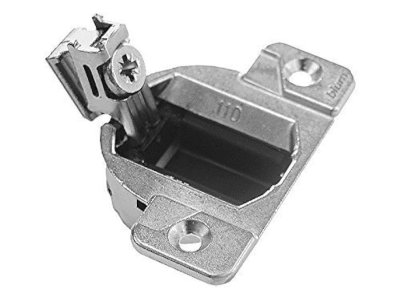Mike Goetzke
Member
- Joined
- Jul 12, 2008
- Messages
- 1,175
Thanks for the help - They are 3/4" overlay compact hinges. I just made a sample and drilling the holes using the pins as a center punch seems to be a solution. These doors are not to big so this should work.Those look like the back plate from a Compact Clip hinge.
Yes, the pins are there to reference off the back of the face frame. Drilling holes for the pins is another option. Then again, try tapping the pin into the panel?
I’m not at the shop but from memory the front edge of the plate will line up with the front edge of the case. Pull one of the vanity doors tp verify where they align.
The only issue will be how the door will swing, they will not work if the panel is less that the door thickness plus 3/8” from a vertical obstruction. Compact hinges just swing, Cliptop hinges swing along the vertical plane and move in across the horizontal plane.
Tom
The doors swing fine. Think I'm good to go. Now to hang this beast up.It is the location of the door more than the size. If the door hinge edge is to close to a vertical surface the door as it swings will hit the surface.
Tom
Actually these are their latest compact clip on slow close.The images look like die castings. These would be either very old Blum hinges or very old Amerok hinges. In any case, consider replacing them with self-closing modern ones with the same offset.
The images look like my old Amerock hinges and replacing mine required only drilling new pilot holes for the screws. Fast and easy with a Vix bit.
My error. I have not seen these before. My old Amerock hinges (in service from about 1980 to 2023) were die castings and held up very well. They (and Blum) switched to stampings no doubt because of the lower cost.Actually these are their latest compact clip on slow close.
Think with the 3/4" overlap I lucked out that these worked in a frameless position.

We install 10,000+ Blum hinges a year, 99.9999999999% of then being the stamped hinge. I have yet to have a hinge failure. In the last 7 years I have had 3 or 4 slide failures, the failures have all been in the soft close mechanism. Biggest issue we have with slides is the countertop installers having to grind the top in place and they don’t cover the slides. The dust gets in them and it cannot be cleaned out. This is not a slide/warranty issue, the builder is charged for us to go out and replace the slides.My error. I have not seen these before. My old Amerock hinges (in service from about 1980 to 2023) were die castings and held up very well. They (and Blum) switched to stampings no doubt because of the lower cost.
My perception is that die cast hinges are higher quality, though I have nothing to back that up with. They look and feel like a better quality product. Die castings can be made to very tight tolerances. The risk is that zinc die castings can be brittle and can crack. Iron, steel, or stainless steel die castings are much stronger. A magnet will tell which it is. All will likely have a nickel plating finish and will look and feel nice.
I saved the old Amerocks, and when I get home I will test them with a magnet. I’m seriously curious now.
This is the Blum casting I found online:
View attachment 378438
